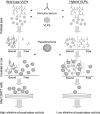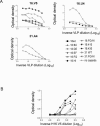Identification of human papillomavirus type 16 L1 surface loops required for neutralization by human sera
- PMID: 16641259
- PMCID: PMC1472072
- DOI: 10.1128/JVI.80.10.4664-4672.2006
Identification of human papillomavirus type 16 L1 surface loops required for neutralization by human sera
Abstract
The variable surface loops on human papillomavirus (HPV) virions required for type-specific neutralization by human sera remain poorly defined. To determine which loops are required for neutralization, a series of hybrid virus-like particles (VLPs) were used to adsorb neutralizing activity from HPV type 16 (HPV16)-reactive human sera before being tested in an HPV16 pseudovirion neutralization assay. The hybrid VLPs used were composed of L1 sequences of either HPV16 or HPV31, on which one or two regions were replaced with homologous sequences from the other type. The regions chosen for substitution were the five known loops that form surface epitopes recognized by monoclonal antibodies and two additional variable regions between residues 400 and 450. Pretreatment of human sera, previously found to react to HPV16 VLPs in enzyme-linked immunosorbent assays, with wild-type HPV16 VLPs and hybrid VLPs that retained the neutralizing epitopes reduced or eliminated the ability of sera to inhibit pseudovirus infection in vitro. Surprisingly, substitution of a single loop often ablated the ability of VLPs to adsorb neutralizing antibodies from human sera. However, for all sera tested, multiple surface loops were found to be important for neutralizing activity. Three regions, defined by loops DE, FG, and HI, were most frequently identified as being essential for binding by neutralizing antibodies. These observations are consistent with the existence of multiple neutralizing epitopes on the HPV virion surface.
Figures




References
-
- Bosch, F. X., and S. de Sanjose. 2003. Human papillomavirus and cervical cancer—burden and assessment of causality. J. Natl. Cancer Inst. Monogr. 31:3-13. - PubMed
-
- Breitburd, F., R. Kirnbauer, N. L. Hubbert, B. Nonnenmacher, C. Trin-Dinh-Desmarquet, G. Orth, J. T. Schiller, and D. R. Lowy. 1995. Immunization with viruslike particles from cottontail rabbit papillomavirus (CRPV) can protect against experimental CRPV infection. J. Virol. 69:3959-3963. - PMC - PubMed
-
- Carter, J. J., L. A. Koutsky, J. P. Hughes, S. K. Lee, J. Kuypers, N. Kiviat, and D. A. Galloway. 2000. Comparison of human papillomavirus types 16, 18, and 6 capsid antibody responses following incident infection. J. Infect. Dis. 181:1911-1919. - PubMed
-
- Carter, J. J., L. A. Koutsky, G. C. Wipf, N. D. Christensen, S. K. Lee, J. Kuypers, N. Kiviat, and D. A. Galloway. 1996. The natural history of human papillomavirus type 16 capsid antibodies among a cohort of university women. J. Infect. Dis. 174:927-936. - PubMed
-
- Carter, J. J., M. M. Madeleine, K. Shera, S. M. Schwartz, K. L. Cushing-Haugen, G. C. Wipf, P. Porter, J. R. Daling, J. K. McDougall, and D. A. Galloway. 2001. Human papillomavirus 16 and 18 L1 serology compared across anogenital cancer sites. Cancer Res. 61:1934-1940. - PubMed
Publication types
MeSH terms
Substances
Grants and funding
LinkOut - more resources
Full Text Sources
Other Literature Sources
Molecular Biology Databases

